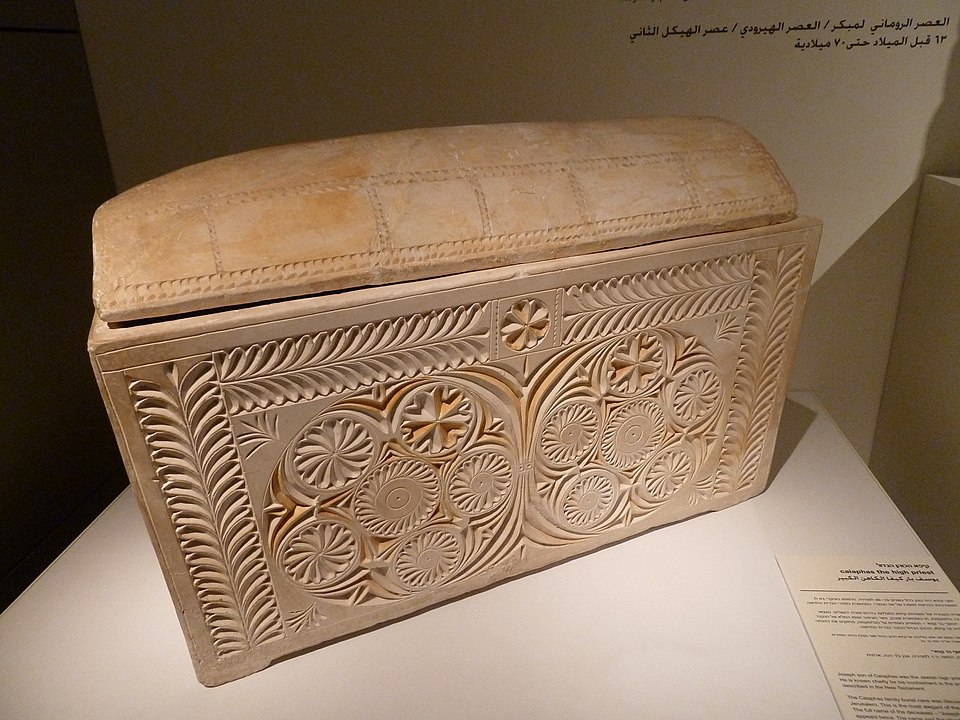
🧭 Introduction
The Caiaphas Ossuary is a remarkable archaeological discovery that provides significant evidence of Joseph Caiaphas, the high priest of the Sanhedrin during Jesus’ trial in the early 1st century AD. Disovered in Jerusalem in 1990, this limestone burial box (ossuary) bears the inscription “Joseph, son of Caiaphas,” directly linking it to the high priest mentioned in the Gospels of John and Matthew. This archaeological find is significant because it confirms the historical existence of a key figure in the New Testament narrative, verifying its reliability.
🏺Discovery and Description
In December 1990, construction workers uncovered a burial cave in the Peace Forest area of Jerusalem. In the cave, they found twelve ossuaries, two of which were inscribed with forms of the name “Caiaphas.” The most elaborate of these ossuaries bears the inscription “Joseph son of Caiaphas” on both sides. Furthermore, the bones inside were those of a 60-year-old man, consistent with the age of the high priest during the time of Jesus.
📖 Biblical Significance
Caiaphas appears explicitly in the New Testament in John 11:49–52 and Matthew 26:57:
John 11:49-52: – “But one of them, Caiaphas, who was high priest that year, said to them, ‘You know nothing at all. Nor do you understand that it is better for you that one man should die for the people, not that the whole nation should perish.’ Now he did not say this of his own accord, but being high priest that year he prophesied that Jesus would die for the nation, and not for the nation only, but also to gather into one the children of God who are scattered abroad”
Matthew 26:57 – “Then those who had seized Jesus led him to Caiaphas the high priest, where the scribes and the elders had gathered.”Additionally, Matthew 26:63–64 and Mark 14:53 refer to the high priest during Jesus’ trial but do not mention his name. On the other hand, Luke 3:2 and Acts 4:6 directly refer to Caiaphas in a different context:
Luke 3:2 – “during the high priesthood of Annas and Caiaphas, the word of God came to John the son of Zechariah in the wilderness.”
Acts 4:6 – “with Annas the high priest, Caiaphas, John, and Alexander, and all who were of the high-priestly family.”
These passages collectively show that Caiaphas was the recognized high priest at the time of Jesus’ ministry, providing a clear historical anchor for the ossuary.
📜 Historical Significance
The Caiaphas Ossuary provides concrete evidence that Caiaphas existed and held the office of high priest during the early 1st century AD. This aligns perfectly with the New Testament accounts and extra-biblical sources such as Josephus, who records Caiaphas’ role in the Jewish leadership at the time of Jesus’ ministry, and reinforces the historical context of the Gospel narratives.
⚖️ Authenticity and Scholarly Debate
The Caiaphas Ossuary is widely accepted as authentic by scholars. Its inscription clearly references the high priest Caiaphas, and the burial style, craftsmanship, and Second Temple period context all align with what is known from historical and biblical sources. While a few early critics questioned aspects of the ossuary, such as the plainness of the tomb or minor details of the inscription, the scholarly consensus affirms that it belongs to the high priest Caiaphas and provides concrete archaeological evidence of his historical existence.
🏛️ Why This Discovery Matters: Historical Validation
The Caiaphas Ossuary provides tangible evidence of a central figure in the New Testament, most notably in the trial of Jesus. By confirming the existence of Caiaphas, this discovery supports the historical reliability of the Gospels and the Book of Acts, adding to the growing body of archaeological and historical evidence that affirms the biblical narrative. Archaeology keeps uncovering what Scripture has declared all along: that the Bible’s testimony is reliable, and its history undeniable.
📚 References & Image Credits
- “Ossuary of the High Priest Joseph Caiaphas.” Center for Online Judaic Studies
- Downing, Ray. “Caiaphas Bones.” Ray Downing Blog
- Credo House. “Top Ten Biblical Discoveries in Archaeology: Caiaphas Ossuary.“
- Image: Caiaphas Ossuary — Photo by or_avi, Wikimedia Commons, CC BY-SA 3.0

Leave a Reply